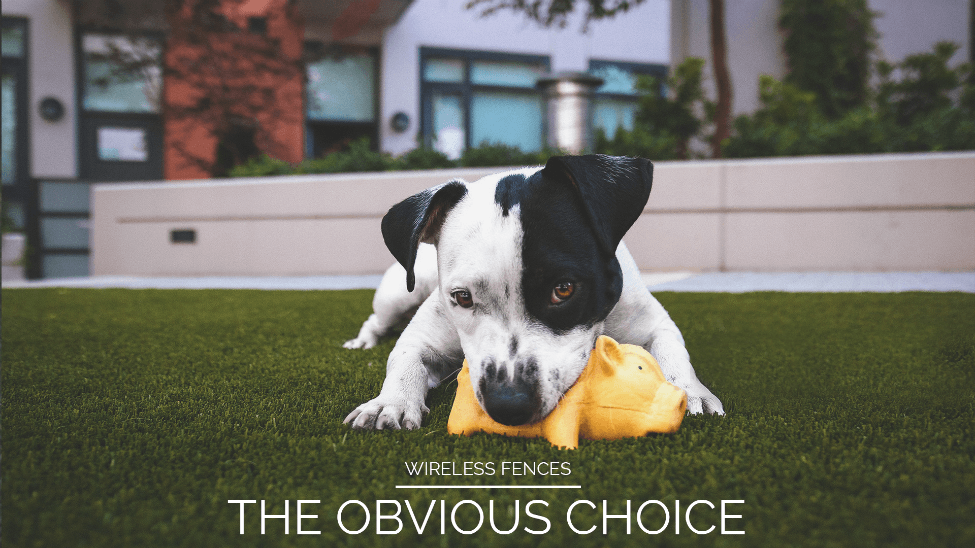Wireless Dog
Fence Solutions
Weighing the advantages of each, for your dog
Have you ever considered installing one of those “wireless” fences for your dog? What have you heard about them? Are you hesitant because you think they involve shock collars and painful corrections for your pooch? Does it seem too complicated, unreliable, and expensive? Read our short comparison of the advantages and disadvantages of both traditional and wireless fences.
But what will the neighbors say?
You just moved into the area, into the house of your dreams, and want to keep your dog happy and safe in his new home. You also want to be a good neighbor, who can contain and control his dog, keeping him from becoming the local nuisance. Erecting a traditional fence should do the job, right?
Well, yes and no. Consider this: traditional fences do provide privacy for your family, and will keep OUT most other dogs and wildlife. And for certain breeds, like some hunting dogs, a traditional fence fits the bill for sufficient dog containment.
However, before you head down to the local big box hardware store for materials, consider some of the disadvantages of having a traditional fence. First, will your neighbors approve of it? The proliferation of Homeowner Associations (HOAs) across America means that there may be a number of rules and regulations to adhere to, should you want to install a new fence around your home. They typically have the final say over style, materials and dimensions.
Also, there are maintenance and repair costs, in addition to any construction costs. If your pup is a digger or a jumper, and most are, expect to constantly monitor the fence for scratches, holes, chewing marks, and the possibility of escape.
Wireless fence: the obvious choice for today?
Homeowners have some great choices today when it comes to keeping their pets safe and contained. And foremost among those choices is an invisible barrier or fence around your house. Since the 1990s they have soared in popularity, and chances are you know someone who has one for their pets.
How does a wireless fence work?
An wireless fence consists of three basic items: a boundary wire, buried in the ground in the designated area, a remote transmitter to emit signals and a small, box-like receiver, fitted on the collar, to receive the signals and safely curb the dog.
What are the advantages of having a pet fence?
For the homeowner, there is the ability to showcase your home and landscaping. No need for repairs, apart from a possible broken wire, and very little maintenance. Fences are easily customizable, with the ability to cordon off gardens, pools, or any area you want pet-free. No asking the HOA for permission (but do check your CC&Rs for possible restrictions.) And, most importantly, they are a humane alternative for your dog, using a brief, tickle-like sensation to warn him to stay within his own yard. No sudden spasms or shocks, just a little reminder to remain in the enclosure.
Leave this project to the pros!
In this age of the internet, Wikipedia and YouTube tutorials, certainly with just a few key strokes and some time, you can research and learn how to install your own dog fence. After all, you just need the three items mentioned earlier, and they are easily obtained at any hardware store, or on Amazon. But do you really have the time to invest, to do this well? And, more importantly, do you have the time afterwards to train your dog on the new system? Most professional dog trainers give themselves a couple of weeks to accomplish this task; ask yourself, are you up to the task?
Pet StopⓇ-your one-stop fence solution
There are several pet fence companies ready to help you out with your predicament, but only one fence company proudly manufactures its product here in the USA: Pet StopⓇ! Pet StopⓇ offers three great choices: the EcoLite, the UltraElite, and the PCC-200 (a Consumers Digest Best Buy award winner.) All systems include the in-ground wiring, the collar and its receiver, and a transmitter.
The secret sauce: GentleStepsTM
Before we describe the system components themselves, a quick word about GentleStepsTM, the amazing and effective training program to help your dog become acclimated to his new fence quickly. Unlike a DIY fence or most other suppliers, Pet StopⓇ‘s Gentle StepsTM uses a barely-noticeable correction, the mildest sensation, in the receiver to gently and incrementally train the dog to recognize his limits. It is a low-stress approach that, along with consistent training, yields great results. This program comes standard with the EcoLite and UltraElite setups.
Innovative features, plus durable design
All three systems feature best in high-tech innovation: the receivers weigh less than two ounces, and are able to alert you to a low battery, a broken wire, or a non-operational unit. The receivers are also programmable to your dog’s temperament, with progressive and standard correction modes available. The signal transmitters can be placed in a basement or garage, but are sturdy enough to withstand challenging weather conditions. With Power Loss Memory, Wire Break Indicator, StabiliTemp and Lightening Protection, you can rest assured that your dog, and your fencing system, are in good hands.
Our other services:
 Pet Stop
Pet Stop Get a Free Quote
Connect with Your Local Pet Safety Experts at Pet Stop. Visit, call, or
chat with us – we’re here to help you create the ultimate safe haven for your pet.
Get a Free quote
Name *
Zip code where new fence is required *
What breed is your dog?
Preferred contact method *
Phone Number to Call/Text *
Address *
Stay Connected, Stay in Control
Brief introduction to the OT-300, highlighting remote control, real-time notifications, and easy setup through the Pet Stop Link App.
Download the App

